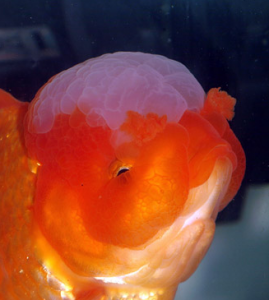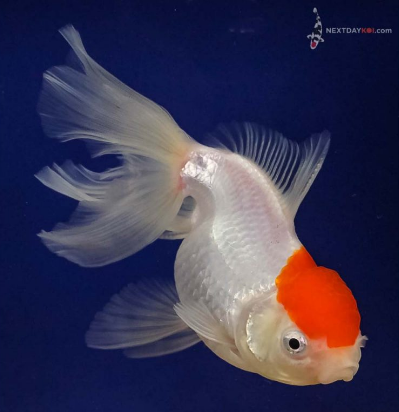Goldfish facts
Oranda Fancy Goldfish
The Oranda is believed to have been around since the 1500s. The Chinese gave it the handle “flower of the water.”It is believed to have been developed from the crossbreeding of a Lionhead and a Veiltail.
The name Oranda derives from a case of mistaken identity. When this Chinese fish was brought to Japan, it was mistakenly believed to have come from the Netherlands. The name Oranda is derived from the Japanese for “Dutch Iron Mask.”
These Fancy Goldfish can grow up to as large as 12 inches, although 8-10 inches is more common. Like the other “rounder” breeds of Fancy Goldfish, the preferred body dimension is that the body depth be ⅔ of the body length.
The Crown
 The defining feature of this Fancy Goldfish is its wen (or crown), which is a benign growth from selective breeding. The Oranda is thought to be the first fancy goldfish to sport the wen.
The defining feature of this Fancy Goldfish is its wen (or crown), which is a benign growth from selective breeding. The Oranda is thought to be the first fancy goldfish to sport the wen.
A traditional Oranda wen should be restricted to the top of the head. Its wen can extend down off the top of the head, but should not be as extensive as a Lionhead goldfish (which covers the cheeks and gill plates).
The wen resembles a raspberry and looks like a brain on the outside of their head. It can become quite large as the Oranda grows and can sometimes impede eyesight as well as its ability to swim.
The wen starts to grow at around 3-4 months and is fully developed at around 2 years old.
Unlike some of the other hooded goldfish, the wen is prominent on the top part of the head. Although seemingly obtrusive, the growth is benign and the reason for this particular breed’s popularity.
The wen is also susceptible to bacteria, so special attention must be paid to it to ensure that a bacterial infection does not set in. It is a good idea to limit any decorative features in the tank (or at least remove anything with sharp edges) to minimize the likelihood of introducing bacteria to the wen.
Additionally, for the wen to fully develop, the Oranda must receive proper care, that includes clean water within the correct parameters, good filtration and a good diet.
Ideally, the wen should be well-developed but not overdeveloped. An overdeveloped wen can lead to issues with vision as well as breathing.
Colors
The Oranda comes in a spectacular range of colors
- calico,
- orange,
- red,
- chocolate,
- bronze,
- white,
- silver,
- red-white,
- red-black,
- Panda-colored (black and white),
- Tricolor,
- Blue (which are a recent addition and rare).
Scales
An Oranda’s scales can either come as metallic or matte and in any combinations or colors
Metallic scales have an underlying layer of guanine (a crystalline pigment), which refracts light giving the scale it’s shiny, full-colored appearance.
Matte scales are translucent scales with no guanine to reflect light. It doesn’t have the same vibrancy in color of a metallic scale and as such is not as popular.
Fins
The Oranda is a double-tailed Fancy Goldfish. The caudal tail should be split into four lobes and when at rest, the tails will fan out like a sail behind it. It also has a single dorsal fin with pairs of pelvic, pectoral and anal fins.
Care Recommendations
At the minimum, an Oranda Goldfish will need a 20-gallon tank to develop to a healthy size. Ammonia and nitrite levels need to be kept as close to zero as possible and nitrates as low as possible.
Temperature
Although a Goldfish, the Oranda is not as hardy as common goldfish. They are best suited to tank life where the temperature is between 65-79ºF.
Cleaning
Weekly gravel (or tank) cleanings are recommended as these goldfish do generate a large amount of waste. Also, make sure that the water is well oxygenated as goldfish are known for needing high oxygen concentrations.
Weekly water changes are also highly recommended with anywhere from 25-40% of the water being changed (depending on water parameters).
Temperament
They are very social and sociable goldfish. They will often pal around with other Goldfish in the tank. They are slow swimming and aggressive.
Because the Oranda is not the most svelte of swimmers, due to its body shape (which is more ovoid or egg-like), it is recommended that they share a tank with other slow swimming breeds so that competition for food doesn’t become an issue.
Feeding
Orandas are omnivores so will eat both pellet and live food. Soaking the pellets is also helpful for the Oranda’s overall digestion. Variety in the diet is good. Other foodstuffs can include peas (which are also believed to aid digestion), lettuce, brine shrimp, frozen bloodworms, krill, daphnia. Protein-rich diets can be helpful with wen development, too.
The Oranda has no stomach, so small amounts of food more frequently is better for digestion.
They are also foragers and will sift through gravel, so make sure your gravel is large enough for the Oranda not to swallow as it can result in severe injury or death.
Varieties
Like other Fancy Goldfish breeds, there are varieties within the breed.
- Tigerhead—full hoods (like a Lionhead) but with a dorsal fin
- Goosehead—an elongated wen that grows upward, not outwards
- Redcap—a white Oranda with a fully red wen
- Dragon Eyes—Oranda with telescope eyes
- Azuma Nishiki—Oranda with calico-nacreous scales
- Pom Pom— or hana fusa is a Pom Pom goldfish with a dorsal fin
Because they require more attention than some of their less ornate cousins, Orandas are not necessarily for first-time goldfish owners. They are, however, incredibly popular amongst enthusiasts around the world.




